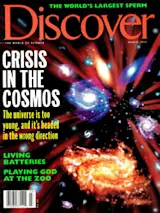On the morning of June 28, 1992, when a magnitude 7.3 earthquake hit the town of Landers, 100 miles east of Los Angeles, it did more than jolt southern Californians awake: it triggered thousands of smaller quakes, most less than magnitude 3, all over California, as well as in Nevada, Utah, and Idaho. Seismometers even picked up tremors in Yellowstone National Park, nearly 800 miles away. The people at the U.S. Geological Survey in Menlo Park could see these things coming in, in real time, and they knew right away that something weird was going on, recalls Alan Linde, a geophysicist at the Carnegie Institution of Washington. The idea of seismic triggering at a distance was a major surprise to all of us.
In many places the seismic waves from Landers seemed to have given the push to faults that would have ruptured eventually anyway. But the hundreds of small quakes that occurred near the ski resort of Mammoth Lakes, 250 miles north of Landers in the Sierra Nevada, were different. Mammoth Lakes lies in a caldera--a giant volcanic crater--called Long Valley, and that caldera is underlain by a large chamber filled with molten rock. It was bubbles rising through that magma, say Linde and his colleagues, that set off the post-Landers tremors.
Long Valley itself was formed 700,000 years ago in a catastrophic eruption that scattered ash all over the western United States. After that the volcano stayed quiet for the most part until 15 years ago, when it was shaken by a series of quakes much larger than the recent ones--a sign that it had received a fresh infusion of magma from below. Concerned about the potential for another eruption, researchers flocked to the site; among them were Linde and seismologist Roger Bilham of the University of Colorado. Now Long Valley is dotted with seismometers and other instruments.
For four days after the Landers quake, those instruments detected seismic activity far in excess of the usual. A detailed analysis of the data, Linde and Bilham found, suggests that the seismic waves from Landers had raised the pressure in the magma chamber. It swelled in response, stressing the fractured rock above and setting off the flurry of quakes. One might call it indigestion, Bilham jokes. But how could an earthquake 250 miles away cause that?
At its source, tens of miles beneath the surface, Long Valley's magma contains quite a lot of gas in solution--carbon dioxide, for instance. As the magma rises, the pressure on it decreases, as does the amount of gas it can hold. By the time the magma reaches the chamber, four miles under Long Valley, much of the gas has come out of solution, forming bubbles. Some of those bubbles become trapped in fissures at the bottom of the magma chamber--until something jostles them loose. The seismic waves from Landers, says Linde, did just that: They sloshed the whole magma body backward and forward a tiny bit, enough to change the geometry of the bubbles' connection to the rock. It's the beer-glass effect--you tap the side of the glass and the bubbles come up.
As bubbles rise from the bottom of the magma chamber, they tend to expand because the amount of rock lying over them, and thus the pressure on them, decreases. But their expansion is resisted by the surrounding magma, which has nowhere to go. As a result, the pressure in the whole magma chamber rises--much as the pressure rises in a closed bottle of beer if you shake it. In the case of the magma chamber, though, the seal isn't perfect; there are cracks in the overlying crust. It yields a little bit and moves the rock enough to have earthquakes, says Linde.
As far as he and Bilham can tell, fortunately, the small tremors triggered at Long Valley by the Landers quake have no bearing on the danger that worries the residents of Mammoth Lakes: the danger of a catastrophic volcanic eruption. The town of Mammoth Lakes is at the edge of a great blister that is growing at about an inch per year, says Bilham. There is a fairly strong possibility it will erupt. If what happened 700,000 years ago happened today, there wouldn't be much left of Mammoth Lakes, and not much left of California. But there is no increased chance of that happening because of the quakes.














